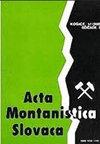Mining Industry 4.0 – Opportunities and Barriers
IF 1.4
4区 地球科学
Q2 GEOSCIENCES, MULTIDISCIPLINARY
引用次数: 3
Abstract
Safety, development, and efficiency are the main slogans that guide modern mines. At the beginning of the fourth industrial revolution, they are familiar with innovations and modern technologies that allow them to create innovative solutions and build an environmentally friendly mining sector. The aim of the paper was to assess the feasibility of implementing the assumptions of the industrial revolution 4.0 in the mining industry. Based on the author's own research and literature research, a set of scenarios for the transformation process was developed. After the verification, three alternative scenarios related to the transformation process 4.0 in mines were used for the research. The transformation scenarios were assessed from the perspective of individual stakeholder groups. The NAIADE (Novel Approach to Imprecise Assessment and Decision Environments), which so far has not been used in the mining industry to assess development scenarios, the method was used to assess the transformation scenarios. The research identified and characterized nine groups of stakeholders. Based on the conducted structured interviews, a set of technical criteria for the assessment of scenarios was defined. The analysis results from the impact matrix and social impact matrix developed for the first time for the mining industry transformation scenarios. Based on the analysis of the impacts of individual factors, it was shown which scenario is the most acceptable for stakeholders and the best from a technical point of view. The research focuses on the deficit of digital competencies and the generational change, as well as the change in the competency requirements of the new type of worker-miner-operator 4.0.矿业4.0 -机遇与障碍
安全、发展和效率是指导现代矿山的主要口号。在第四次工业革命开始时,他们熟悉创新和现代技术,这些技术使他们能够创造创新的解决方案,并建立一个环保的采矿部门。本文的目的是评估在采矿业实施工业革命4.0假设的可行性。基于作者自己的研究和文献研究,开发了一套转换过程的场景。验证后,使用了与矿山改造过程4.0相关的三种替代场景进行研究。转型方案是从各个利益相关者群体的角度进行评估的。NAIADE(不精确评估和决策环境的新方法)迄今尚未在采矿业中用于评估开发场景,该方法用于评估转型场景。该研究确定了九组利益相关者并对其进行了表征。在进行结构化访谈的基础上,确定了一套情景评估的技术标准。分析结果来自首次为采矿业转型场景开发的影响矩阵和社会影响矩阵。根据对个别因素影响的分析,从技术角度来看,哪种情况最能为利益相关者所接受,也是最好的。研究的重点是数字能力的不足和代际变化,以及新型矿工操作员4.0能力要求的变化。
本文章由计算机程序翻译,如有差异,请以英文原文为准。
求助全文
约1分钟内获得全文
求助全文
来源期刊

Acta Montanistica Slovaca
地学-地球科学综合
CiteScore
3.60
自引率
12.50%
发文量
60
审稿时长
30 weeks
期刊介绍:
Acta Montanistica Slovaca publishes high quality articles on basic and applied research in the following fields:
geology and geological survey;
mining;
Earth resources;
underground engineering and geotechnics;
mining mechanization, mining transport, deep hole drilling;
ecotechnology and mineralurgy;
process control, automation and applied informatics in raw materials extraction, utilization and processing;
other similar fields.
Acta Montanistica Slovaca is the only scientific journal of this kind in Central, Eastern and South Eastern Europe.
The submitted manuscripts should contribute significantly to the international literature, even if the focus can be regional. Manuscripts should cite the extant and relevant international literature, should clearly state what the wider contribution is (e.g. a novel discovery, application of a new technique or methodology, application of an existing methodology to a new problem), and should discuss the importance of the work in the international context.
 求助内容:
求助内容: 应助结果提醒方式:
应助结果提醒方式:


